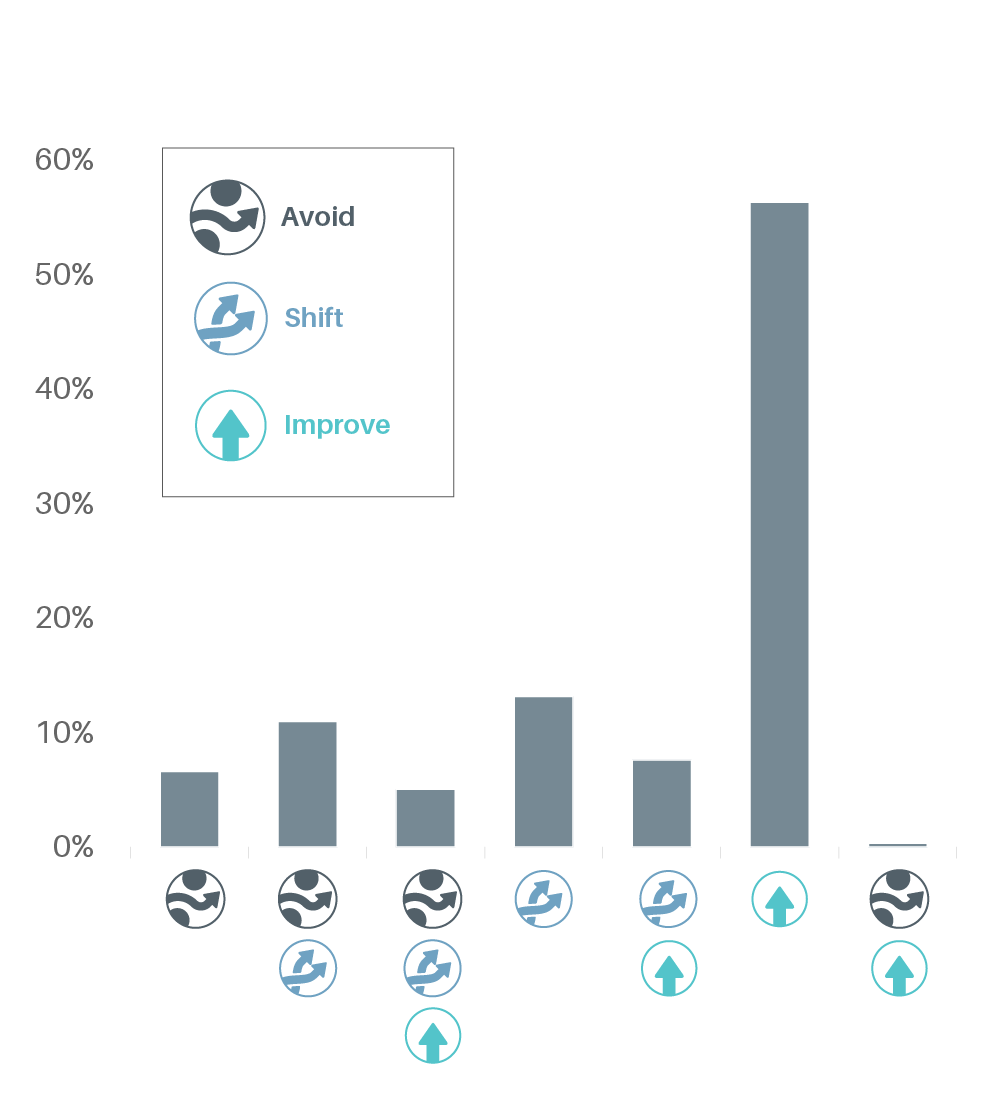National Policy Frameworks for Transport and
Climate Change
To achieve the goals of the Paris Agreement, the transport sector must accelerate climate action immediately to achieve decarbonisation by mid-century. Under the Agreement, Parties to the UN Framework Convention on Climate Change are required to submit Nationally Determined Contributions, or frameworks and strategies outlining their specific targets and actions to reduce emissions. NDCs communicate planned mitigation and adaptation actions by the Parties, including plans to achieve resilient, low carbon transport systems.
In addition to NDCs, the UNFCCC provides several mechanisms under the Paris Agreement to describe intended measures and ambitions on climate change mitigation and adaptation. These include: Long-Term Low Emission Development Strategies (LT-LEDS); National Adaptation Plans (NAPs); National Adaptation Programmes of Action (NAPAs); and Nationally Appropriate Mitigation Actions (NAMAs). The Paris Agreement also provides a mechanism for collaboration among Parties and so-called non-Party stakeholders (all stakeholders that are not national governments) through the Marrakech Partnership for Global Climate Action. The Marrakech Partnership elaborates Climate Action Pathways, which set out visions for various sectors – including transport – to achieve a 1.5 °C resilient world in 2050.
Sustainable transport is an important component of additional UN frameworks on sustainable development and resilience, including the 2030 Agenda for Sustainable Development (and its Voluntary National Reviews (VNR) for tracking progress towards these goals), as well as the adaptation and resilience objectives of the Sendai Framework for Disaster Risk Reduction (and its Global Assessment Report). There is significant potential to strengthen the nexus between the UNFCCC mechanisms for the Paris Agreement and the 2030 Agenda and Sendai Framework. Enhancing linkages among these global frameworks and their monitoring and reporting processes can help assure that progress towards climate change mitigation and adaption yields broader positive impacts on sustainable development.
The COVID-19 pandemic impacted transport and climate change policy frameworks, resulting in a postponement of the 2020 UN Conference on Climate Change (COP26) and in shifts in submissions for new NDCs. The pandemic has also prompted efforts to include low carbon transport measures in national recovery plans.
Key Findings
- Nationally Determined Contributions (NDCs) in the framework of the Paris Agreement
During 2015 and 2016, 166 first-generation NDCs were submitted (from 165 countries, plus the European Union-28); 76% of these highlight transport as an important sector for climate mitigation, but only 8% include specific targets for reducing transport emissions.
From November 2018 through May 2021, 54 second-generation NDCs were submitted (from 53 countries, plus the European Union-27); 72% of these include specific measures for mitigating transport emissions, but only 15% include a specific target for reducing transport emissions, showing insufficient progress towards meeting Paris Agreement goals.
Among second-generation NDCs, “Improve” measures account for 53% of all measures (versus 52% in first-generation NDCs); “Shift” measures account for 19% (versus 32% in first-generation NDCs); and “Avoid” measures account for 8% (versus 6% in first-generation NDCs), with other measures being cross cutting. This illustrates a continued bias towards technological solutions.
Figure 1.
Avoid, Shift and/or Improve transport measures in second-generation NDCs

Among second-generation NDCs, 15 countries have increased their attention to climate change adaption for transport (28%, compared to 4% of first-generation NDCs), although fewer than 6% include a transport adaptation target.
While 37% of second-generation NDCs make reference to Long-Term Low Emission Development Strategies, there is potential to more strongly leverage transport decarbonisation synergies between these mechanisms.
While 13 second-generation NDCs set higher targets for reducing economy-wide emissions, a recent assessment estimates that current pledges would still lead to warming of 2.6 degrees Celsius (°C) by 2100, far exceeding the Paris Agreement goals.
- Voluntary National Reviews (VNRs) of the United Nations Sustainable Development Goals (SDGs) in the framework of the UN 2030 Agenda for Sustainable Development
Figure 2.
Transport and the SDGs: Four cross-cutting themes

Among VNRs submitted in 2020, 48% connect transport to SDG 13 (Climate Action), while only a single VNR submission sets a specific transport target, illustrating the need for further alignment between Paris Agreement mechanisms and the 2030 Agenda for Sustainable Development.
Figure 3.
Shares of VNRs submitted in 2020 that connect transport with different SDGs

Among second-generation NDCs, 13% establish direct linkages between sustainable transport measures and specific SDGs, including SDG 3 (Good Health and Well-Being), SDG 11 (Sustainable Cities and Communities) and SDG 13 (Climate Action).
Creating a common methodological framework between the Paris Agreement and the implementation and monitoring mechanisms for the 2030 Agenda can maximise the combined potential of both global frameworks for accelerating sustainable, low carbon transport.
- Long-Term Low Emission Development Strategies (LT-LEDS) in the framework of the Paris Agreement
All 29 LT-LEDS submitted from November 2016 through May 2021 contain references to transport sector actions, and more than 20% propose specific targets for mitigating transport emissions.
Submitted LT-LEDS focus strongly on “Improve” measures (representing 56% of all measures), whereas only 13% represent “Shift” measures and 7% represent “Avoid”
Figure 4.
Transport measures in Long-Term Low Emission Development Strategies

- Linkages between national climate change planning processes and Paris Agreement mechanisms
NDCs are increasingly referencing national climate change and strategic plans, to enhance synergies in the interest of accelerating transport decarbonisation and sustainability objectives.
Many countries have captured enhanced ambition on transport in recent national climate change plans and commitments, which complement measures detailed in global climate change mechanisms.
- Impacts of COVID-19 on transport and climate change policy frameworks
In 2020, due to the pandemic, the UN Conference on Climate Change (COP26, originally scheduled for November) and other key processes around the UNFCCC were delayed, resulting in shifted timelines for progress towards updated NDCs and NAPs.
To accelerate collective and timely action towards a low carbon transport transition, many initiatives were announced at the En Route to COP26 event in December 2020.
The pandemic has prompted low carbon transport measures in national recovery efforts, which should be linked to the development of enhanced NDCs.

